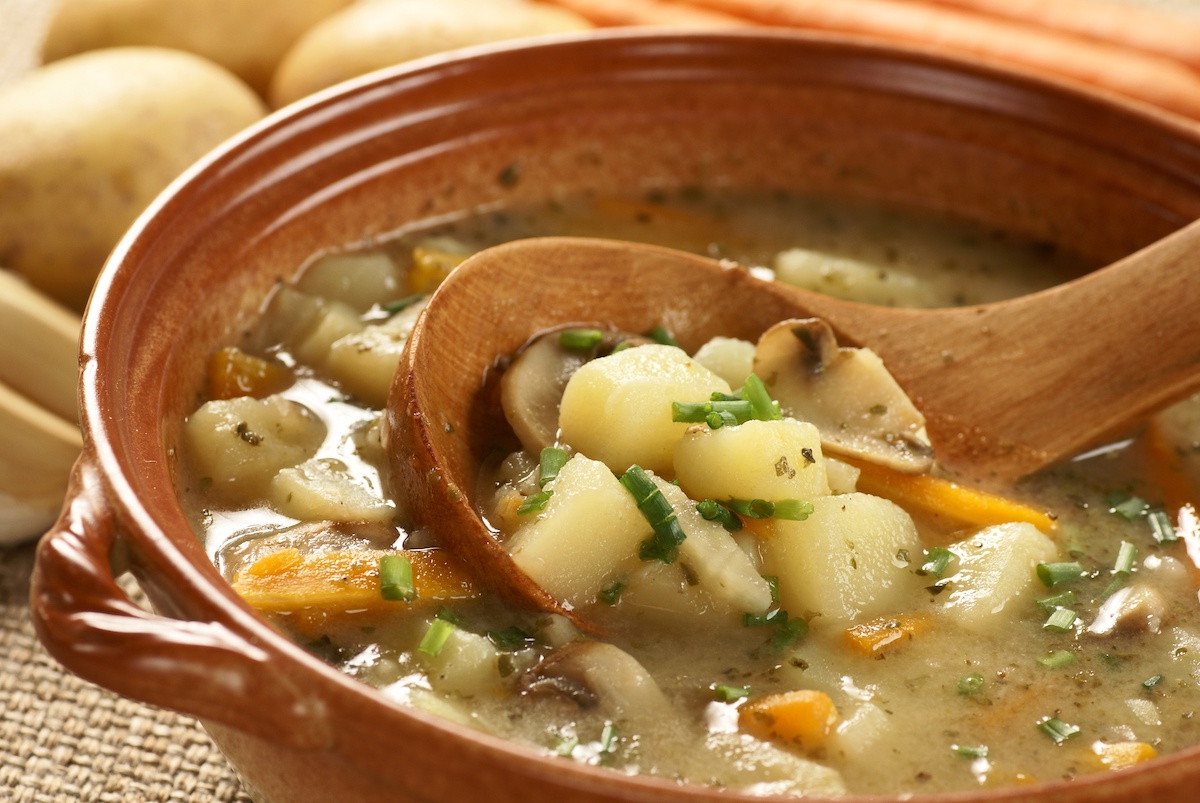You have hours cooking and, when you try the preparation, you realize that you spent a lot with the salt. Don’t worry, that happens to all of us at some point, and that’s why we tell you how to fix a salty meal, using very practical tricks that will get you out of that culinary predicament.
Of course, keep in mind that none of the techniques that we propose eliminate excess sodium; they only help you hide its taste. For this reason, we recommend beforehand that every time you cook a dish, you correct the salt point or rectify the salt during the process.
Also, when correcting a very salty dish, add the corrective ingredient little by little, as you taste the preparation. You can also scoop out a small portion of it and add the concealer to it first. That said, we invite you to take a look at our tricks to desalt different types of food: stews, roasts, sauces, creams, and many more.
How to remove excess salt in soup and stews?
When we pass the salt in a stew or soup, we have the advantage that its content is mostly liquid, and this allows a range of very effective possibilities to solve this problem. Some of the tricks to fix a salty meal are:
Submerge an old stale bread during the boiling process
Put it in the center of the casserole and make sure that the bread does not fall apart too much, because later you need to remove it (leave it there for 10-15 minutes). This ingredient will absorb a portion of the salt, but also part of the liquid, so you should add a little more water or broth to the preparation.
Add a potato during cooking
Cut a potato into thick slices and add. Cook it for 10 minutes and remove it with a spoon.
Incorporate more water in the preparation
Before, remove that same amount of liquid to balance the portions. Once the water is added, cook the preparation until it acquires the desired texture. This trick is among the best, as it avoids altering the original flavor of the food, but if you don’t apply it from the beginning, the food will be overcooked.
Increase the amount of ingredients
Add twice as many ingredients without adding more salt. This procedure allows you to balance the flavor.
Add a sweet ingredient
Try ½ tsp. of refined or brown sugar and, if the food is still too salty, add an additional pinch until you reach the desired point.
It also works to add some natural sweetener, either whole or crushed. You can use a pinch of brown paper, a prune, a natural fig, a sweet potato, half an apple, or others. If you add some of these whole ingredients, once the cooking is finished, remove them from the preparation (except for the paper, as it is diluted).
Pour an acid product
You can serve the juice of ½ lemons, a splash of vinegar (red, white, rice or spices), tomato juice or wine. Stir the chosen ingredient, until it is integrated into the preparation.
Dissolve 1 teaspoon of cornstarch in 1/4 glass of plain water
This trick works very well, but do not exceed the dose, because the preparation will be too thick. Remember, starch is an ally to reduce the salty taste in preparations, and it is not only found in cornstarch, but also in potatoes, sweet potatoes, rice, pasta, etc.
Add milk, half cream or heavy cream
This trick works well in creamy stews. You just have to add a couple of tablespoons and stir very well.
Pour soda and milk
Add them in equal parts and mix them very well. If the stew does not accept milk in its preparation, use only soda.
Tip: never go overboard with the corrective ingredients, as you will harm the taste of the food.
How to fix a salty sauce?
If you are preparing a sauce and it is very salty, you can use any of the tricks that we mentioned in the first section, although the most suitable for you will depend on the type of recipe you are preparing.
For example, if you make a cooked sauce and it contains butter or cream, you can increase only that ingredient (if it is butter, use it without salt).
When it comes to vinaigrettes and dressings, a good way to reduce salt is to add oregano or double the ingredients in the recipe.
How to fix a very salty meat?
If you are wondering how to recover a roast that has become very salty, one of the following easy tricks will surely help you:
- Cut off the outside of the meat. If you verified that the interior is not so salty, apply this trick. Then, serve the meat with its sauce and accompaniment, making sure that these contain little salt, in order to balance the flavors.
- Add a little bit of some sour or sweet flavor. You can use any of the following ingredients: lemon juice, apple cider vinegar (they also serve red, white, rice or spiced wine), a pinch of honey or a little paper.
- Add vegetables while it cooks. During cooking, put several raw potatoes, carrots and/or sweet potatoes around it, either whole or cut into thick slices (previously peeled). In case it is a bird, you can also place the vegetable inside. This technique not only helps counteract the very salty taste, but also keeps the juiciness in the meat.
Reduce salt in creams
Do you need to desalt a cream? Then follow the following recommendations to know how to recover a salty meal. Remember to check the flavor of the preparation several times while applying any of these techniques:
- Add ½ apples without seeds. Cook the cream for 10-20 minutes, and before the cooking time is up, remove the remains of the fruit.
- Double the amount of food. If you put more vegetables without salt, the flavor will be balanced.
- Dilute 1 teaspoon of cornstarch in 1/4 glass of plain water. The starch absorbs the salty flavor of the cream and gives it more texture.
- Add milk, cream or half cream. A couple of tablespoons will suffice, and then stir well.
How to fix salty vegetables?
Did you cook boiled vegetables and go overboard with the salt? Rinse them with water as long as they are not too soft. This same procedure works for roasted or steamed vegetables. In the case of vegetables that have already been dressed, you can dress them again if they lost much of their flavor during the process.
How to reduce excess salt in bakery dough?
Excess salt in bread or pastry dough delays the fermentation process and can even stop it. Do not forget that baker’s yeast is based on microorganisms, which are inactivated when they come into direct contact with salt.
Consequently, bread or any other similar product loses volume, darkens excessively and is not very tasty. If this happens to you by accident, do not discard the dough immediately, first check the taste of it. Depending on how salty it is, apply one of the following solutions:
- Add a little more sugar. Sweet and sour flavors serve to overshadow the presence of salt. This trick works on dough’s whose excess salt is not so noticeable.
- Double the ratio of ingredients. In this way, you counteract the taste of the salt, since it will be distributed evenly throughout the rest of the dough. In addition, you will get more bread or pastries. Additionally, it may be a good idea to add a little more yeast in the preparation, since the proportion of dough is greater, and perhaps the yeast added at the beginning is already inactive due to the salt.
- Add spices or cheese. If the dough is not so salty, add oregano or basil. Instead, if it is very salty dough, put salt-free cheese and a little more yeast. The recipe will be delicious!
How to recover a very salty pasta?
Did you prepare a delicious sauce but the spaghetti was very salty? Don’t worry, right now we’ll teach you how to recover a salty paste without much complication, applying one of the following alternatives:
- Put the cooked paste in a colander immediately after removing it from the heat. Rinse it with cold water straight from the tap. Once rinsed, try a couple of strips. If you like the taste, drain the pasta and serve it, if not, repeat the operation. Remember that cold water also slows down the cooking of the pasta.
- Serve the pasta with cheese without salt. This option balances the flavors, and you can complement it with the previous technique.
- Add milk to the cake. Depending on what sauce you put on it, you can either sit the paste in the liquid for a while and then discard it or mix it all together and heat it up a bit until it evaporates.
Tip: The paste must be al dente to apply these techniques, otherwise it will lose texture.
How to fix a salty rice?
Perhaps rice is the most difficult food to repair when we have gone too far with salt, due to its texture. But do not be discouraged; in the kitchen almost everything has a solution, so here are some good tricks to fix already cooked salty rice:
Rinse the rice
If it’s al dente white rice, nothing else, then this trick can work for you. Just when you verify that the grain is ready, check if it is very salty or not. If it’s too salty, immediately strain it through a sieve, and give it a quick rinse under running water.
Once drained, check the flavor and repeat if necessary, but do not overdo it, because this procedure can affect the texture of the grain. Using this technique, you not only eliminate the salty taste, but also shorten the cooking time.
Add lemon or another acidic product
If you missed the salt in paella, garden rice, rice with spices or in simple white rice, this trick will come in handy. In this case, add the juice of ½ a lemon or a splash of apple cider vinegar, and mix carefully. Avoid exceeding the dose, as you can alter the original flavor of the recipe.
Pour milk if the rice is creamy
You prepared creamy rice and it was salty. In this case, since it is rice that is not dry, you can add 1-2 tablespoons of milk.
Add a potato
Add it well washed, raw and unpeeled, during cooking. Once the rice is cooked, remove it. This trick only works if you realize in time that the rice is getting too salty.
How to fix a salty mash?
Do not discard the puree because you do not know how to reduce salty food, just boil and grind the same amount of vegetables, but without salt, and add it to the salty part. Additionally, you can add a little milk. It will be delicious!
Beans
Beans are labor intensive, time consuming, and depending on the recipe, can contain many ingredients. Can you imagine throwing them away just because they are too salty? Well, you won’t have to with the tricks to fix salty food that we give you below:
- Rinse the beans with water. Put the beans in a colander, drain the liquid from them, and rinse them under cold tap water. If they already had stew, this will be lost, but they will retain some of their flavor. Taste a few grains and, if required, repeat the process. Finally, put the beans back in the saucepan, add water, and cook them again with seasonings, already fried. If you cook beans that have been stewed, do so for 10-15 minutes. Instead, if you cook the beans without stewing, cook them for 15-20 minutes or until they reach the desired point.
- Add baking soda. For every 4 cups of beans, add 1 teaspoon of baking soda. Then, boil them for 5 minutes.
- Stir a potato into the beans. Peel it and put it whole or chopped right in the center of the pot. If the beans are too salty, add three potatoes. At the end of cooking, you have two options: remove the pieces or leave them. This trick also works using 1 whole peeled apple.
- Add some acid product. Try a splash of vinegar or the juice of 1/2 lemon, and stir very well. Once added, it rectifies the flavor of the beans. If it requires a little more, you can add it, as long as it doesn’t change the original flavor of the food.
- Prepare the same amount of beans, but without salt. Once ready, join them with the salted beans and, thus, the level of salt will be balanced.
- Put sugar or paper. This trick will only work well with black beans.
Ham, anchovies or chorizo
There are food products such as ham, anchovies and chorizo that sometimes have a very intense taste of salt, and we do not want to taste them that way. In those cases, it is only enough to wash them a little under the tap before preparing them.



